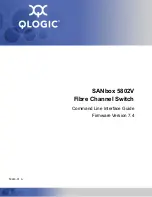
xStack DGS-3400 Series Layer 2 Gigabit Ethernet Managed Switch
To configure
Traffic Control
, enable or disable the
Broadcast Storm
,
Multicast Storm
and
DLF
using their corresponding pull-
down menus. Click
Apply
to implement changes made.
Parameter Description
Traffic Control Recover
Unit
Choose the Switch ID number of the Switch in the switch stack to be modified.
From… To
Select the ports to be shutdown.
Traffic Trap Configuration
Traffic Trap
Enable sending of Storm Trap messages when the type of action taken by the Traffic Control function
in handling a Traffic Storm is one of the following:
•
•
•
•
None
– Will send no Storm trap warning messages regardless of action taken by the Traffic
Control mechanism.
Storm Occurred
– Will send Storm Trap warning messages upon the occurrence of a
Traffic Storm only.
Storm Cleared
– Will send Storm Trap messages when a Traffic Storm has been cleared
by the Switch only.
Both
– Will send Storm Trap messages when a Traffic Storm has been both detected and
cleared by the Switch.
This function cannot be implemented in the Hardware mode. (When Drop is chosen in the Action
field.
Traffic Control Settings
From…To
Select the ports of this Switch to configure for Storm Control.
Broadcast
Enables or disable Broadcast Storm Control.
Multicast
Enables or disables Multicast Storm Control.
DLF
Enables or disables Destination Lookup Failure (DLF) storm control. (Not available for Software
based Traffic Control {Shutdown}).
Action
Select the method of traffic Control from the pull down menu. The choices are:
Drop
– Utilizes the hardware Traffic Control mechanism, which means the Switch’s hardware will
determine the Packet Storm based on the Threshold value stated and drop packets until the issue is
resolved.
Shutdown
– Utilizes the Switch’s software Traffic Control mechanism to determine the Packet Storm
occurring. Once detected, the port will deny all incoming traffic to the port except STP BPDU packets,
which are essential in keeping the Spanning Tree operational on the Switch. If the Countdown timer
has expired and yet the Packet Storm continues, the port will be placed in Shutdown Forever mode
and is no longer operational until the user manually resets the port using the Storm Control Recover
setting at the top of this window. Choosing this option obligates the user to configure the Interval
setting as well, which will provide packet count samplings from the Switch’s chip to determine if a
Packet Storm is occurring.
Threshold
Specifies the maximum number of packets per second that will trigger the Traffic Control function to
commence. The configurable threshold range is from 0-255000 with a default setting of 131072.
Count Down
The Count Down timer is set to determine the amount of time, in minutes, that the Switch will wait
before shutting down the port that is experiencing a traffic storm. This parameter is only useful for
ports configured as Shutdown in their Action field and therefore will not operate for Hardware based
Traffic Control implementations. The possible time settings for this field are 0, 5-30 minutes. 0 is the
default setting for this field and 0 will denote that the port will never shutdown.
Interval
The Interval will set the time between Multicast and Broadcast packet counts sent from the Switch’s
chip to the Traffic Control function. These packet counts are the determining factor in deciding when
incoming packets exceed the Threshold value. The Interval may be set between 5 and 30 seconds
with the default setting of 5 seconds.
182
Summary of Contents for xStack DGS-3426P
Page 310: ...D Link D Link D Link D Link 495 744 00 99 http www dlink ru e mail support dlink ru...
Page 316: ...International Offices...
Page 318: ......
















































